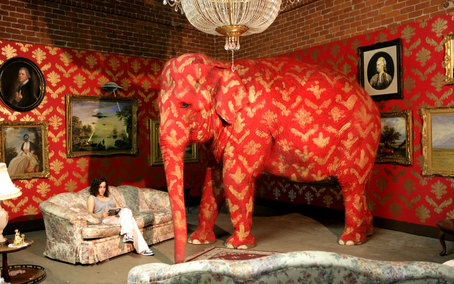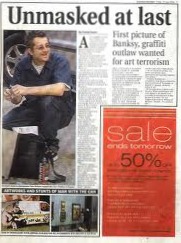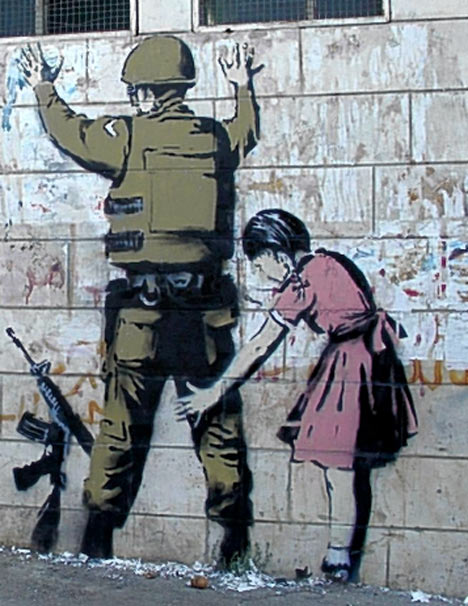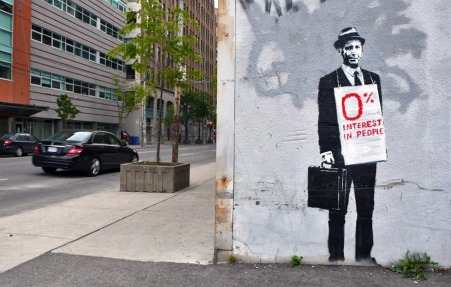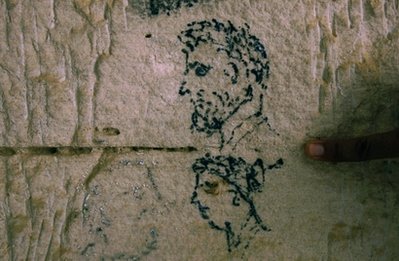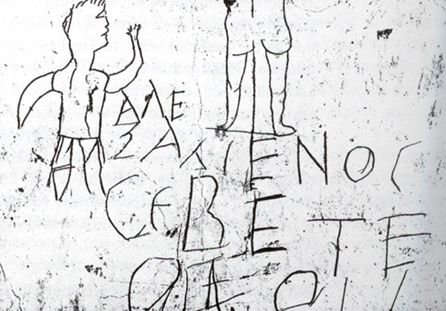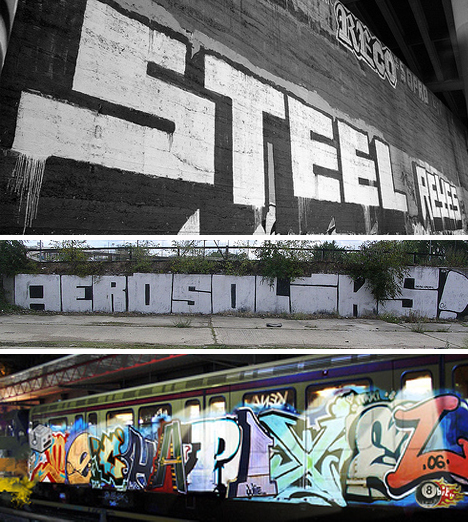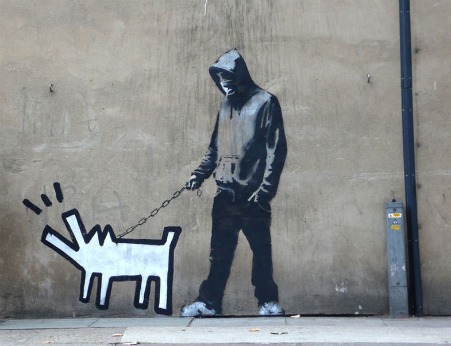BANKSY street art KILROY
Mr. Brainwash
JAMES FRANCO
graffiti KEITH HARING
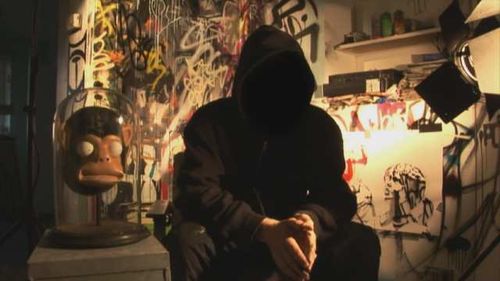
There are four basic human needs: food, sleep, sex and revenge.
— Banksy
Banksy Pranksy
Even a great satirist would be hard pressed to think this one up: Famous British street artist is nominated for an Oscar for best documentary, a film that exposes the herd instinct of the public and the gullibility of the art world.
The movie is called Exit From the Gift Shop, a film by Banksy.
When Banksy is on screen, he wears a hoody that artfully obscures his face, and his voice is altered. Why the latter? Does he have an identifiable accent like maybe from Bristol, England, or thereabouts? Or a squeaky voice?
More questions:
Is Exit a joke? A hoax? A mockumentary? An exercise in the self-reflexive?
A po-mo promo?
Above, I first typed Exist Through the Gift Shop. Typos are auguries.
Whether the film was scripted in advance or improvised or even discovered during the editing process is irrelevant; it is still a pretty funny film. You will always be reminded of it when you are leaving the Guggenheim Museum in New York and you actually have to exit through the gift shop, one of the most annoying tricks ever played on the museum-going public.
Why not enter through the gift shop, save admission, and just look at the souvenirs — which are sometimes better than the actual art? I routinely check out gift shops — posters, cards, jigsaw puzzles, placemats, calendars and all such souvenirs of iconic artworks — on my way out to make sure I have not missed any warhorses, because once or twice in museums other than the Guggenheim, I have, and had to circle back.
Actual art tends to be too big and far too grubby, right? Posters, cards, jigsaw puzzles, placemats, and calendars are neat, clean and useful as gifts.
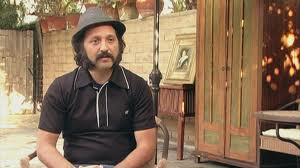
Thierry Guetta, L.A. rag-merchant, cinematographer, aka Mr. Brainwash. From: Exit from the Gift Shop
From Rags to Riches
Last week I noticed Exit Through the Gift Shop was available on Netflix instant-streaming. With the Academy Awards coming up, how could I resist? I approached it with trepidation.
Turns out I loved it, love the way it suddenly (spoilers! spoilers!) turns around and turns upside-down two-thirds through.
Exit begins as if amateur filmmaker and artist-stalker Thierry Guetta’s footage — and the footage of him shooting his footage — is going to be all there is to the film. We start with Guetta’s Parisian “cousin,” the real-life Space Invader who specializes in hit-and-run mosaics.

And then on to other fabulously famous street artists like Shepard Fairey (celebrated for his Obama “Hope” poster).
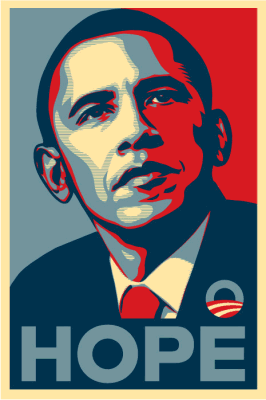
But the elusive Banksy, who in a possibly self-serving twist of self-imagining portrays himself as the ultimate goal of Quetta’s quest, insists that he see some of the footage amassed by his fan, his sycophant. We are offered a brief sample of the first cut of Guetta’s Live Remote Control. Quetta has been shooting himself in the foot. It looks like a parody of an art film. Bruce Connor takes on street art? Fast cuts; but unlike Connor, no guts.
When Banksy urges Guetta to become a street artist instead of a filmmaker, he surrenders his footage to Banksy and reinvents himself as Mr. Brainwash. The film we are watching, now overtly by Banksy, is suddenly all about a goofy, cartoon-French, used-clothing mogul living in L.A. who suddenly becomes a Street art celebrity through Banksy-type stencils of himself wielding a camera.
Very droll.
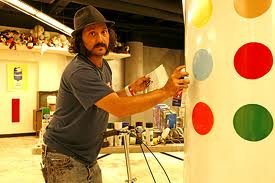
Thierry Guetta becoming Mr. Brainwash.
Cover of L.A. Weekly? Well, why not?
I checked it out in that rag’s online archive. Yes, indeed. Here’s a pic.
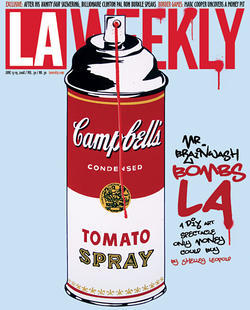
And, yes, like Banksy’s self-produced “Barely Legal” ’06 mega-exhibition in L.A., someone going by the name of Mr. Brainwash pulled off the same in ’08, but called it “Life Is Beautiful.”
Here’s a blogger’s description of the ’06 Banksy show with lots of pictures.
Banksy’s stenciled elephant from “Barely Legal,” 2006.
Rumors now in circulation:
Banksy is Guetta.
Banksy, adding “comic actor” to his talents as artist and filmmaker, plays both Guetta and himself in the movie.
The real-live Guetta is the real-life Banksy, a Frenchman based in L.A.
Banksy, not Mr. Brainwash, is the faux artiste. Or….
Both were created by Jeffrey Deitch, ex-dealer from N.Y.C. and now director of MOCA-LA, in an effort to publicize his forthcoming “Art in the Streets” exhibition at the Geffen Contemporary.
Banksy is Brad Pitt, the art collector.
Banksy is James Franco, another multi-talented artist — the smiling co-host of the 83rd Annual Academy Awards. He was nominated for best actor, and also lost.
Exit is a remake of Dream of a Rarebit Fiend (Porter/Edison, 1906, not 1903) or was actually made by Christopher Guest, the mockumentary genius.
Art on the Run
No doubt about it, Banksy, whoever he is, is famous. He may be the “former public schoolboy from middle-class suburbia” as claimed by the Daily Mail.
Or he may be a collective. But why should anyone care? Because many in high and in low places are taken with the Banksy brand.
What exactly is the Banksy product that has established willy-nilly or perhaps quite self-consciously the Banksy brand?
You can go to his website or, at least, what seems to be his website (everything is in doubt) and see some outdoor art, indoor art, and some souvenirs. The style is identifiable: relatively realistic stenciled figures up to something or another, usually no good. And it’s all quite sarcastic. .
The stenciled images are ephemeral, except in those instances in which aggressive collectors have purchased entire walls or buildings in order to own (and surely later sell) authentic Banksy artworks.
Banksy is the new Damien Hirst. The new Andy Warhol. Let’s hope he’s not the new Salvador Dalí .
Banksy Portfolio:
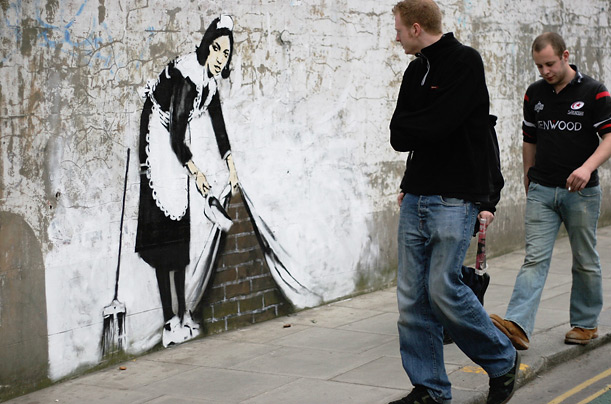
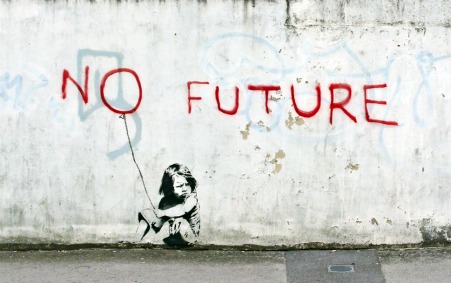
But where did it all begin?
A Brief History of Graffiti (Part One): Kilroy Was Here
Although vandalistic graffiti is ephemeral, it is in some ways eternal – or at least perennial. What is there about a flat surface in public that cries out for…speech. The impulse to leave your mark or to advertise yourself, taunt, or deface is apparently universal. Unsolicited additions to walls go back to ancient Egypt, to Rome and Pompeii, or to World War II.
Portolio:
Graffiti on walls of Kom Ombo Temple, Ptolemaic Dynasty, Egypt,350-30BC
Graffiti from city of Leukaspis, N.D.
Graffiti on wall in Pompeii
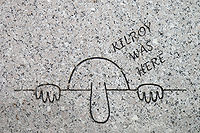
G.I. graffiti, W.W. II, Europe
A Brief History of Graffiti (Part Two): It’s All About Love
Oh, yes. I remember modern graffiti. According to most accounts — some of them quite academic — it started in Philadelphia, c. 1966. Philadelphia has a lot to answer for, and not just the invention of solitary confinement at Eastern State Penitentiary. What became graffiti art was called “bombing” then, and Cornbread (Darryl McCray) and Cool Earl were the stars. Cornbread himself on his website dates his invention of graffiti to his love-starved youth. He was trying to impress a girl he was interested in. Cornbread was McCray’s nickname in an unidentified “juvenile institution.” But when he got out …
I met this girl in school named Cynthia. I used to like Cynthia a lot. I would walk her home from school everyday ’cause I was trying to be her boyfriend. I started writing “Cornbread loves Cynthia” all over the neighbourhood (sic) She didn’t know Cornbread and I were the same person, she just knew me as Darryl. It played on my mind ’cause Cornbread seemed to get more attention from her than I did. One day many months later, she saw “Cornbread loves Cynthia” written on my school book and she realized who I was. That’s when she fell in love with me.
But b
A Brief History of Graffiti (Part Three): From Philly to the BMT
Suddenly “tags” by TAKI 183 began to appear in New York City. Did this happen spontaneously, or is there a special land bridge from Philly to New York as there once was from Siberia to North America?
First TAKI 183. Then whole subway cars got “tagged” by spray-can art. Styles proliferated at a breakneck speed. Writing went crazy: Wild style, Throw-Up, Blockbuster, Broadway, Bubble, WigglesB boy, Flava Wildstyle, Shadow, Chinese, Puzzle. Was it art? George Kubler once said if a group of things laid out chronologically exhibited rapid and nonfunctional modifications, we were probably looking at art of some sort. So much for the eternally transcendent.
In 1974, Norman Mailer, that champion of great art, published The Faith of Graffiti.
I have a soft spot for calligraphy — Japanese, Chinese, and Arabic and, if you remember, pseudo-calligraphy in all traditions including the paintings of Brion Gysin — but this guerrilla “writing” in New York was a nuisance. It was flamboyantly decorative; possibly territorial; and best seen as a new kind of urban folk art.
Spray-can graffiti spread like a weird fungus among us, from the BMT and the IRT to drainage ditches, elevated-roadway underbellies (“heaven”), rooftops, and walls. Hundreds of walls. Savvy art dealers began bringing it indoors. And I began to rue the day I had not ripped off the beautiful chalk drawings that Keith Haring did on the black surfaces of unrented advertising rectangles on subway platforms. Oh, that howling wolf. And the radiant baby.
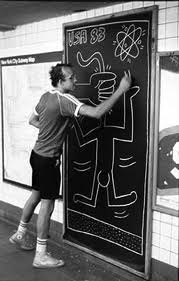
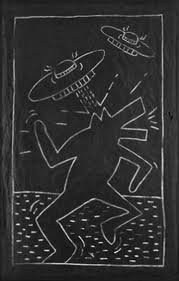
Bear in mind, however, that the kind of street art I was officially interested in — we called it Street Works in 1969, in order to parody Earthworks — was performance-based. A poet roller-skated down Fifth Avenue; a male artist walked 14th Street in drag. A soon-to-be-mad poet commandeered her own hotdog stand. Your truly made phone calls from phone booth to phone booth in Midtown, hanging up before the phones were answered. Street Works V, the final extravaganza, had 500 or so artist and poet participants. Although there was sometimes litter (Arakawa), the litter could be swept away. And although stencils were sometimes employed by the likes of maverick Thomas Lanigan-Schmidt, his rats and his words have eluded art history.
Art history is interested only in what is up for auction. “Object Art” stenciled on the street-level wall of the Whitney moat is the Lanigan-Schmidt contribution to guerrilla art I remember most. Then again, he did stenciled rats everywhere, knowing them firsthand in his Lower East hovel, which was wildly decorated with cellophane and permanent Xmas lights…and rats made out of aluminum foil.
It’s the rats that are up for auction. 
And the writings-on-the-wall? Graffiti of the ’80s is so yesterday; Haring was the best. But the rest, as they came in from the cold and had gallery shows? Nada. Even Haring was better outside. Will the same be true of Banksy? We cannot even bear to look at the paintings of poor, dead Jean-Michel Basquiat, in spite of the film about him. But maybe it’s because of the Warhol collaborations, which are as if Duchamp were playing catch-up, ripping off some handsome, drug-addled teenager who had just come in out of the rain.
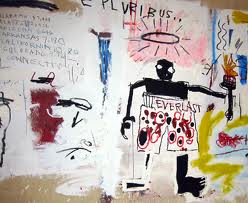
Basquiet graffiti
Bansky taking Haring dog for walk…..
Is Classification Pacification?
The “street art” entry on Wikipedia offers this definition: “Typically, the term street art or the more specific post-graffiti is used to distinguish contemporary public-space artwork from territorial graffiti, vandalism, and corporate art.”
But it goes on to cite a 1981 exhibition at the Washington Project for the Arts in D.C. called “Street Art.” The first use of street art as a term? When I checked it on the WPA site, it seems the exhibition was actually called “Streetworks”!
In any case, street art now is intended as art, whereas I would bet that the early graffiti artists — before art-school dropouts took over — did not think of their murals as having anything to do with Picasso or Diego Rivera.
But wait a minute. Weren’t the graffiti loners and crews extremely competitive, just like real artists? Didn’t they call their biggest works “pieces,” which is short for “masterpieces”?
Here’s a reference to street art that can be verified. The Tate Modern in 2008 had an exhibition called “Street Art.” Blu, Faile, JR, Nunca, Os Gemeos, and Sexeart created murals on the Tate’s river façade. Because the murals were legal and sanctioned, I don’t think they were street art. But to give credit where credit is due, they were about street art. Got the words right; got the art wrong.
Have there been any earlier uses of the term? Scholars, please get to work. Confirmed sources only.
* * *
Whatever the date of origin, Street art fits the bill. Alternate terms such as post-graffiti and neo-graffiti don’t really seem to work. Graffiti etymologically screams out words, yells out writing. And because of media exposure is identified with spray-can paint. Graffiti is not a large enough term to encompass the various kinds of unofficial, unsanctified art that continue to take place in the streets all over the world. Words, yes. But also images (stenciled, pasted, or whatever), objects (Banksy’s bent booth), and various performance-based manifestations including flash mobbing. We needed a bigger term. A new term. And Street Art it is.
We can classify it but can we bring it indoors? Can it be saved?
Changing the context changes the meaning. Saving the art destroys it. Brackets betray. The way things are done now, hanging something on a white wall makes it art. But those very same white walls may do the reverse for street art, draining energy, canceling surprise, setting up unfair comparisons with art actually made for white walls (or at least posh living rooms).
The institutionalization of street art is the destruction of street art. If you like it, you will have to save it from being painted over or scrubbed away. You have to put a fence around it, own it, or bring it indoors. To save it, you have to kill it.
It almost goes without saying that if graffiti is institutionalized as transplanted walls or turned into translations of images onto stretched canvas or paper (i.e., drawings and prints), then all its deep aura is stripped away. The aurafication of contemplative display is no match for the rawness of illegal art. Street art must be a criminal act or it is just murals-as-usual. Also, beyond ghetto bravado — which initially was enough – street art needs to have a message. Territorialization is not enough.
Banksy’s images of a Royal Guard or a mutt peeing on a wall are funny and smart because they give away the territorial aspect of street art and certainly of graffiti before it was subsumed. He quotes Keith Haring. He appropriates Monty Python graphics. He pisses on everything. Banksy claims all walls. Banksy grabs street art for himself.
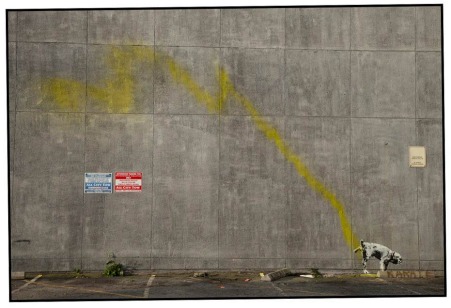
Flim-Flam or Meta-Film?
In the movie, Banksy’s disdainful dismissal of the arty Guetta edit disguises the fact that Exit Through the Gift Shop is itself quite arty. The structure is more important than the subject. The structure is the content. Is this also a parody? Is this a criticism of the self-reflexive trope, so beloved by all in including the proprietor of Artopia? But also a criticism of the cupidity and complicity of artists, not only his alter ego (?) Mr. Brainwash, but even himself?
Well, maybe not that, or at least not blatantly, for how can you criticize an artist who gets into the limelight by staying out of the limelight, has a healthy secondary market, has good politics – I think — and seems to be slamming both the art world, and casting doubts upon every other Street artist in the universe.
Mr. Brainwash’s “Life Is Beautiful” had no painted live elephant like Banksy’s breakthrough show, but looks as if it was jammed with Banksy rejects. Or as Banksy says: “Mr. Brainwash is a force of nature; he’s a phenomenon. And I don’t mean that in a good way.”
Banksy is always quotable. He inherited the Warhol quotability quotient:
The greatest crimes in the world are not committed by people breaking the rules but by people following the rules. It’s people who follow orders that drop bombs and massacre villages
Nevertheless, I smell an infinite regress. You have to make a lot of money to make a film satirizing making a lot of money. Hey, come on, even artists have to eat, and because Banksy is anonymous we do not know exactly how much he is worth.
To be fair, maybe all the money is being made by Banksy’s collectors. However, on the evidence of his art, Bansky travels far and wide, and that costs money. It is also very expensive to remain anonymous. How much, by the way, would it cost to rent a former CBS studio to mount your own art show? To do it twice, the second time to make a faux-doc?
NEVER MISS AN ARTOPIA ESSAY AGAIN!
FOR AN AUTOMATIC ARTOPIA ALERT E-MAIL perreault@aol.com
John Perreault is on Facebook.
You can also follow John Perreault on Twitter: johnperreault
Preview: THE, A Novel by John Perreault.

